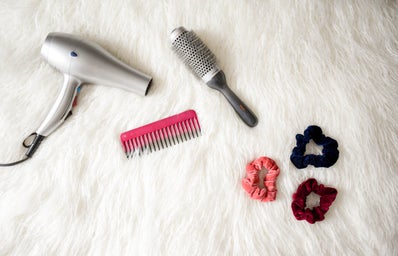Ever since I was a kid, I’ve been told that heat is a big no-no for beautiful and nourished hair. Even though my hair isn’t frizz-free or straight, at least it wasn’t burnt or dried out, because I was constantly letting it air dry after every wash day. That’s until I came across a TikTok that completely changed my way of thinking and made me reconsider everything I thought I knew about hair beauty. So, according to hair school guru and TikTok user @maddy_pratt, “When your hair is wet it’s in the most fragile state it can be in. Your hair is a lot more stretchy when it’s wet and it’s more prone to damage.” In other words, your hair has a higher chance of damage by breakage while it’s air drying. I, taking into consideration that this was a random TikTok I came across at 1 in the morning, made a search about this phenomenon to see if it was true. And Alas! It technically is.
Science agrees!
Scientists at Yonsei University conducted a study titled “Hair Shaft Damage from Heat and Drying Time of Hair Dryer” in 2011. They compared the state of hair strand samples before and after subjecting them to 5 different “treatments”. One treatment was no treatment at all (control group), the second was letting the strands air dry, and the third one was blow-drying for a minute, holding the hair dryer at a distance of 15cm. The fourth one was holding the hair dryer at a distance of 10cm for half a minute, and finally, the fifth one was holding a hair dryer at a distance of 5cm for 15 seconds. The results were shocking. They found that at a closer distance and at a higher heat, the more damage is inflicted to the hair’s surface, but no cortex damage was recorded. Only the hair strands that were air-dried ended up with damaged cell membrane complexes: “The hair shaft swells when in contact with water, as does the delta-layer of the CMC. The delta-layer is the sole route through which water diffuses into hair…”. Their final verdict was that blow-drying at a safe distance (15 cm) is what’s best for healthy hair.
So, if hair drying only damages the hair’s surface, does heat protectant cancel this out completely? What’s the safest way to blow-dry one’s own hair after all?

What to expect while using heat protection.
To answer the first question, according to a dissertation written by Jaesik Hahn, a student at Purdue University, heat protectants actually work, but to a certain extent. A chemical product won’t always be 100% effective. It depends on the exact brand you use. Nonetheless, heat protectants contain silicone, which gives way to a process that “involves retarded penetration of heat by a protectant layer…”. So, maybe using a heat protectant is the answer to avoid superficial hair damage by heat.
The safest way for blow-drying your hair.
On the other hand, to answer the second question, Cim Mahoney, a renowned hair stylist interviewed by Vogue Scandinavia, has a step-by-step process and it actually starts before washing. He says that you should always brush your hair before hopping into the shower. This guarantees that all the oil built up in your scalp is evenly distributed to your strands. After that, you can follow along with your usual shampooing and conditioning routine and when you’re done washing then comes the fun part. He recommends towel drying the hair as much as possible, preferably with a microfiber towel. Then apply a little bit of heat protectant, if you’re going to use a high heat setting, if not, then you can skip this step. The important thing here is to constantly move the hair dryer around, so as to not focus heat on only one area of the hair for a prolonged period of time. Once your hair is 80 percent dry, you can ditch the hair dryer and opt for using a leave-in conditioner treatment to lock in some moisture and tame any flyaways. And voilá! You’ve safely blow-dried your hair.
Now we’ve covered how we can all live out our hair-styling dreams without having to worry so much about the health of our strands. We can finally say goodbye to the days of sleeping with wet hair or putting our hair up while it’s wet (which no, I don’t actually do, and if you do, I’m praying for your hair as you’re reading this). Of course, this is not a call to blow dry your hair every single time you wash it. That’s actually not very ideal because, at the end of the day, heat exposure to hair is still quite damaging, but once in a while will not affect your hair, it can actually be quite the contrary. So, the more you! Happy blow-drying!


